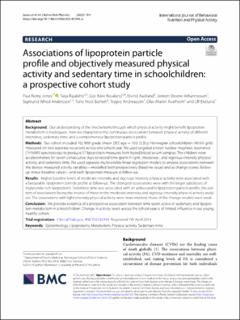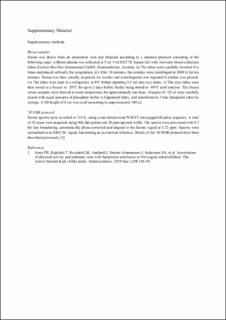| dc.contributor.author | Jones, Paul Remy | |
| dc.contributor.author | Rajalahti, Tarja | |
| dc.contributor.author | Resaland, Geir Kåre | |
| dc.contributor.author | Aadland, Eivind | |
| dc.contributor.author | Steene-Johannessen, Jostein | |
| dc.contributor.author | Anderssen, Sigmund Alfred | |
| dc.contributor.author | Bathen, Tone Frost | |
| dc.contributor.author | Andreassen, Trygve | |
| dc.contributor.author | Kvalheim, Olav Martin | |
| dc.contributor.author | Ekelund, Ulf | |
| dc.date.accessioned | 2022-08-04T08:47:51Z | |
| dc.date.available | 2022-08-04T08:47:51Z | |
| dc.date.created | 2022-04-22T13:14:56Z | |
| dc.date.issued | 2022 | |
| dc.identifier.citation | International Journal of Behavioral Nutrition and Physical Activity. 19(2022), Artikkel 5. | en_US |
| dc.identifier.issn | 1479-5868 | |
| dc.identifier.uri | https://hdl.handle.net/11250/3010086 | |
| dc.description | This article is licensed under a Creative Commons Attribution 4.0 International License, which permits use, sharing, adaptation, distribution and reproduction in any medium or format, as long as you give appropriate credit to the original author(s) and the source, provide a link to the Creative Commons license, and indicate if changes were made. The images or other third party material in this article are included in the article's Creative Commons license, unless indicated otherwise in a credit line to the material. If material is not included in the article's Creative Commons license and your intended use is not permitted by statutory regulation or exceeds the permitted use, you will need to obtain permission directly from the copyright holder. | en_US |
| dc.description.abstract | Background: Our understanding of the mechanisms through which physical activity might benefit lipoprotein metabolism is inadequate. Here we characterise the continuous associations between physical activity of different intensities, sedentary time, and a comprehensive lipoprotein particle profile.
Methods: Our cohort included 762 fifth grade (mean [SD] age = 10.0 [0.3] y) Norwegian schoolchildren (49.6% girls) measured on two separate occasions across one school year. We used targeted proton nuclear magnetic resonance (1H NMR) spectroscopy to produce 57 lipoprotein measures from fasted blood serum samples. The children wore accelerometers for seven consecutive days to record time spent in light-, moderate-, and vigorous-intensity physical activity, and sedentary time. We used separate multivariable linear regression models to analyse associations between the device-measured activity variables—modelled both prospectively (baseline value) and as change scores (follow-up minus baseline value)—and each lipoprotein measure at follow-up.
Results: Higher baseline levels of moderate-intensity and vigorous-intensity physical activity were associated with a favourable lipoprotein particle profile at follow-up. The strongest associations were with the larger subclasses of triglyceride-rich lipoproteins. Sedentary time was associated with an unfavourable lipoprotein particle profile, the pattern of associations being the inverse of those in the moderate-intensity and vigorous-intensity physical activity analyses. The associations with light-intensity physical activity were more modest; those of the change models were weak.
Conclusion: We provide evidence of a prospective association between time spent active or sedentary and lipoprotein metabolism in schoolchildren. Change in activity levels across the school year is of limited influence in our young, healthy cohort. | en_US |
| dc.language.iso | eng | en_US |
| dc.subject | epidemiology | en_US |
| dc.subject | lipoproteins | en_US |
| dc.subject | metabolism | en_US |
| dc.subject | physical activity | en_US |
| dc.subject | sedentary time | en_US |
| dc.title | Associations of lipoprotein particle profile and objectively measured physical activity and sedentary time in schoolchildren: A prospective cohort study | en_US |
| dc.type | Peer reviewed | en_US |
| dc.type | Journal article | en_US |
| dc.description.version | publishedVersion | en_US |
| dc.rights.holder | © The Author(s) 2022 | en_US |
| dc.source.pagenumber | 14 | en_US |
| dc.source.volume | 19 | en_US |
| dc.source.journal | International Journal of Behavioral Nutrition and Physical Activity | en_US |
| dc.identifier.doi | 10.1186/s12966-022-01244-w | |
| dc.identifier.cristin | 2018422 | |
| dc.description.localcode | Institutt for idrettsmedisinske fag / Department of Sports Medicine | en_US |
| dc.source.articlenumber | 5 | en_US |
| cristin.ispublished | true | |
| cristin.fulltext | original | |
| cristin.qualitycode | 2 | |

